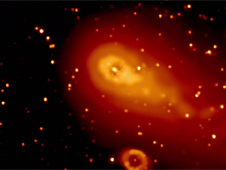Astrophysics Science Division
The Astrophysics Science Division supports the GSFC astrophysics projects by providing scientific leadership and
supports a research program to achieve NASA's strategic science goals. The key questions addressed by the Divisions research
programs include:
- How do galaxies, stars, and planetary systems form and evolve?
- What is the diversity of worlds beyond our solar system?
- Which planets might harbor life?
- What powered the big bang?
- What is Dark Energy?
- What happens to space, time and matter at the edge of a black hole?
- What are the cycles of matter & energy in the evolving universe?
+ Read more about the Astrophysics Science Division
+ Read more about our Laboratories
Links
| 
|
News Feature

Image Credit: NASA/Swift/Stefan Immler and Dennis Bodewits
NASA's Swift Looks to Comets for a Cool View
NASA's Swift Gamma-ray Explorer satellite rocketed into space in 2004 on a mission to study some of
the highest-energy events in the universe. The spacecraft has detected more than 380 gamma-ray bursts,
fleeting flares that likely signal the birth of a black hole in the distant universe. In that time,
Swift also has observed 80 exploding stars and studied six comets.
+ Read more
+ Archive
|
Division News
Jan 9 - Congratulations to Peter Serlemitsos of the X-ray
Astrophysics Laboratory, this
year's winner of the Joseph Weber Prize, awarded by the American
Astronomical Society for major contributions to astronomical
instrumentation.
Dec 1 - Applications invited for one or more CS positions in observational high-energy astrophysics in the X-ray Astrophysics Laboratory.
Oct 20 - Congratuations to Richard Kelley and the SXS team for winning the IRAD Innovator of the Year award. The Soft X-ray
Spectrometer (SXS) team members include
Nicholas P. Costen, Christine Jhabvala, Caroline Kilbourne, Samuel J. Moseley, Takashi Okajima, F. Scott Porter, Peter Serlemitsos, Peter Shirron, and Yang Soong.
Oct 2 -
Mike Mumma (PI), and his colloaborators Carol Grady, Kenji Hamaguchi, Tim Kallman, Marc Kuchner, Rob Petre, and Aki Roberge had a successful
proposal for the Goddard Center for Astrobiology (GCA), part of the NASA Astrobiology Insititute.
|
| 
|
Current Missions
Missions in Development
James Webb Space Telescope (JWST)
JWST is an infrared-optimized space telescope designed
to study the earliest stars and galaxies.
+ Read More
NuSTAR
NuSTAR is a pathfinder mission that will open the high energy X-ray sky for sensitive study for the first time.
+ Read More
Astro-H
Astro-H (formerly known as "NeXT") is a facility-class mission to be launched on a JAXA H-IIA into low Earth orbit.
+ Read More
Stratospheric Observatory for Infrared Astronomy (SOFIA)
SOFIA is a 2.5-meter telescope for infrared to far-infrared astrophysics carried
aboard a Boeing 747-SP aircraft. GSFC is responsible for the SAFIRE
instrument.
+ Read More
Future Missions
Physics of the Cosmos Missions (formerly Beyond Einstein)
Beyond Einstein consists of several missions:
+ Read More
|
|

